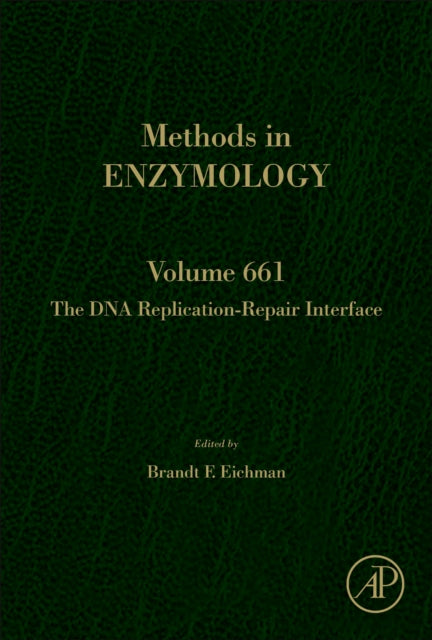Shulph Ink
DNA Replication-Repair Interface
DNA Replication-Repair Interface
- Condition: Brand new
- UK Delivery times: Usually arrives within 2 - 3 working days
- UK Shipping: Fee starts at £2.39. Subject to product weight & dimension
Bulk ordering. Want 15 or more copies? Get a personalised quote and bigger discounts. Learn more about bulk orders.
Couldn't load pickup availability
- More about DNA Replication-Repair Interface
Replication-Coupled Repair, Volume 661 in the Methods in Enzymology series, highlights new advances in the field, including Repair of replication-born DNA breaks by sister chromatid recombination, High resolution and high throughput DNA cyclization measurements to interrogate DNA bendability, A programmable detection method for genomic signatures, Characterization of the telomerase modulating activities of yeast DNA helicases, Eukaryotic DNA replication with purified budding yeast proteins, Single molecule studies of yeast Rad51 paralogs, Light activation and deactivation of Cas9 for DNA repair studies, and more. Other chapters explore MIDAS: Direct sequencing to map mitotic DNA synthesis and common fragile sites at high precision, Studying the DNA damage response in embryonic systems, GLASS-ChIP to map Mre11 cleavage sites in the human genome, New chemical biology approaches to trap reaction intermediates in living cells, Single-molecule imaging approaches for monitoring replication fork conflicts at genomic DNA G4 structures and R-loops in human cells, Monitoring the replication of structured DNA through heritable epigenetic change, Visualizing replication fork encounters with DNA interstrand crosslinks, and much more.
\n Format: Hardback
\n Length: 452 pages
\n Publication date: 16 November 2021
\n Publisher: Elsevier Science & Technology
\n
Replication-Coupled Repair,Volume 661 in the Methods in Enzymology series, presents exciting new advances in the field. This comprehensive volume offers a diverse range of captivating chapters on timely topics, encompassing various aspects of DNA repair mechanisms.
The Repair of replication-born DNA breaks by sister chromatid recombination is explored in depth, shedding light on the intricate processes involved in repairing damaged DNA strands. High resolution and high throughput DNA cyclization measurements are employed to investigate the bendability of DNA, providing valuable insights into its structural dynamics.
A programmable detection method for genomic signatures is introduced, offering a powerful tool for disease diagnosis and genome editing. This method enables the identification and characterization of specific DNA patterns associated with various diseases, paving the way for personalized medicine.
The telomerase modulating activities of yeast DNA helicases are characterized, shedding light on their role in maintaining telomere integrity and preventing genome instability. Eukaryotic DNA replication with purified budding yeast proteins is examined, highlighting the essential components and mechanisms involved in this complex process.
Single molecule studies of yeast Rad51 paralogs unravel the intricate mechanisms of DNA repair and recombination. Light activation and deactivation of Cas9 for DNA repair studies provide new avenues for studying DNA damage and repair mechanisms in living cells.
Other chapters delve into MIDAS: Direct sequencing to map mitotic DNA synthesis and common fragile sites with high precision. Studying the DNA damage response in embryonic systems offers insights into the protective mechanisms against genetic damage. GLASS-ChIP to map Mre11 cleavage sites in the human genome provides valuable information on DNA repair processes.
New chemical biology approaches are employed to trap reaction intermediates in living cells, facilitating a deeper understanding of biological processes. Single-molecule imaging approaches are utilized to monitor replication fork conflicts at genomic DNA G4 structures and R-loops in human cells, providing a detailed view of DNA replication dynamics.
Monitoring the replication of structured DNA through heritable epigenetic change is explored, shedding light on the mechanisms underlying gene regulation and inheritance. Visualizing replication fork encounters with DNA interstrand crosslinks offers a unique perspective on DNA repair processes.
This volume encompasses a wide range of topics, providing researchers and scientists with valuable insights into the field of DNA repair. It serves as a valuable resource for advancing our understanding of genetic diseases, genome editing, and cellular processes.
In conclusion, Replication-Coupled Repair,Volume 661 in the Methods in Enzymology series, presents a comprehensive and up-to-date overview of the latest advancements in DNA repair mechanisms. With its engaging chapters and cutting-edge research, this volume contributes significantly to our understanding of DNA biology and its applications in various fields.
\n Weight: 828g\n
Dimension: 161 x 239 x 27 (mm)\n
ISBN-13: 9780323907330\n \n
This item can be found in:
UK and International shipping information
UK and International shipping information
UK Delivery and returns information:
- Delivery within 2 - 3 days when ordering in the UK.
- Shipping fee for UK customers from £2.39. Fully tracked shipping service available.
- Returns policy: Return within 30 days of receipt for full refund.
International deliveries:
Shulph Ink now ships to Australia, Belgium, Canada, France, Germany, Ireland, Italy, India, Luxembourg Saudi Arabia, Singapore, Spain, Netherlands, New Zealand, United Arab Emirates, United States of America.
- Delivery times: within 5 - 10 days for international orders.
- Shipping fee: charges vary for overseas orders. Only tracked services are available for most international orders. Some countries have untracked shipping options.
- Customs charges: If ordering to addresses outside the United Kingdom, you may or may not incur additional customs and duties fees during local delivery.


